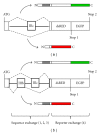Alternative Splicing of Fibroblast Growth Factor Receptor IgIII Loops in Cancer
- PMID: 22203889
- PMCID: PMC3238399
- DOI: 10.1155/2012/950508
Alternative Splicing of Fibroblast Growth Factor Receptor IgIII Loops in Cancer
Abstract
Alternative splicing of the IgIII loop of fibroblast growth factor receptors (FGFRs) 1-3 produces b- and c-variants of the receptors with distinctly different biological impact based on their distinct ligand-binding spectrum. Tissue-specific expression of these splice variants regulates interactions in embryonic development, tissue maintenance and repair, and cancer. Alterations in FGFR2 splicing are involved in epithelial mesenchymal transition that produces invasive, metastatic features during tumor progression. Recent research has elucidated regulatory factors that determine the splice choice both on the level of exogenous signaling events and on the RNA-protein interaction level. Moreover, methodology has been developed that will enable the in depth analysis of splicing events during tumorigenesis and provide further insight on the role of FGFR 1-3 IIIb and IIIc in the pathophysiology of various malignancies. This paper aims to summarize expression patterns in various tumor types and outlines possibilities for further analysis and application.
Figures




Similar articles
-
Expression of fibroblast growth factor receptor-2 splice variants is developmentally and tissue-specifically regulated in the amphibian embryo.Dev Biol. 1994 Jul;164(1):173-82. doi: 10.1006/dbio.1994.1189. Dev Biol. 1994. PMID: 8026621
-
Responsiveness of developing dental tissues to fibroblast growth factors: expression of splicing alternatives of FGFR1, -2, -3, and of FGFR4; and stimulation of cell proliferation by FGF-2, -4, -8, and -9.Dev Genet. 1998;22(4):374-85. doi: 10.1002/(SICI)1520-6408(1998)22:4<374::AID-DVG7>3.0.CO;2-3. Dev Genet. 1998. PMID: 9664689
-
Alternative splicing of fibroblast growth factor receptors in human prostate cancer.Prostate. 2001 Feb 1;46(2):163-72. doi: 10.1002/1097-0045(20010201)46:2<163::aid-pros1020>3.0.co;2-t. Prostate. 2001. PMID: 11170144
-
Role of fibroblast growth factor receptor-2 splicing in normal and cancer cells.Front Biosci (Landmark Ed). 2018 Jan 1;23(4):626-639. doi: 10.2741/4609. Front Biosci (Landmark Ed). 2018. PMID: 28930565 Review.
-
Alternative splicing modulates cancer aggressiveness: role in EMT/metastasis and chemoresistance.Mol Biol Rep. 2021 Jan;48(1):897-914. doi: 10.1007/s11033-020-06094-y. Epub 2021 Jan 5. Mol Biol Rep. 2021. PMID: 33400075 Review.
Cited by
-
HiFENS: high-throughput FISH detection of endogenous pre-mRNA splicing isoforms.Nucleic Acids Res. 2022 Dec 9;50(22):e130. doi: 10.1093/nar/gkac869. Nucleic Acids Res. 2022. PMID: 36243969 Free PMC article.
-
An FGFR-p53 developmental signaling axis drives salivary cancer progression.Oncogene. 2025 Aug;44(32):2876-2892. doi: 10.1038/s41388-025-03444-7. Epub 2025 Jun 2. Oncogene. 2025. PMID: 40456865
-
Fibroblast growth factor signaling in myofibroblasts differs from lipofibroblasts during alveolar septation in mice.Am J Physiol Lung Cell Mol Physiol. 2015 Sep 1;309(5):L463-74. doi: 10.1152/ajplung.00013.2015. Epub 2015 Jul 2. Am J Physiol Lung Cell Mol Physiol. 2015. PMID: 26138642 Free PMC article.
-
Fibroblast Growth Factor Receptor Signaling in Skin Cancers.Cells. 2019 Jun 4;8(6):540. doi: 10.3390/cells8060540. Cells. 2019. PMID: 31167513 Free PMC article. Review.
-
Role of epithelial mesenchymal transition in prostate tumorigenesis.Curr Pharm Des. 2015;21(10):1240-8. doi: 10.2174/1381612821666141211120326. Curr Pharm Des. 2015. PMID: 25506896 Free PMC article. Review.
References
-
- Eswarakumar VP, Lax I, Schlessinger J. Cellular signaling by fibroblast growth factor receptors. Cytokine and Growth Factor Reviews. 2005;16(2):139–149. - PubMed
-
- Givol D, Yayon A. Complexity of FGF receptors: genetic basis for structural diversity and functional specificity. FASEB Journal. 1992;6(15):3362–3369. - PubMed
-
- Jin W, McCutcheon IE, Fuller GN, Huang ESC, Cote GJ. Fibroblast growth factor receptor-1 α-exon exclusion and polypyrimidine tract-binding protein in glioblastoma multiforme tumors. Cancer Research. 2000;60(5):1221–1224. - PubMed
-
- Moffa AB, Tannheimer SL, Ethier SP. Transforming potential of alternatively spliced variants of fibroblast growth factor receptor 2 in human mammary epithelial cells. Molecular Cancer Research. 2004;2(11):643–652. - PubMed
LinkOut - more resources
Full Text Sources
Miscellaneous

